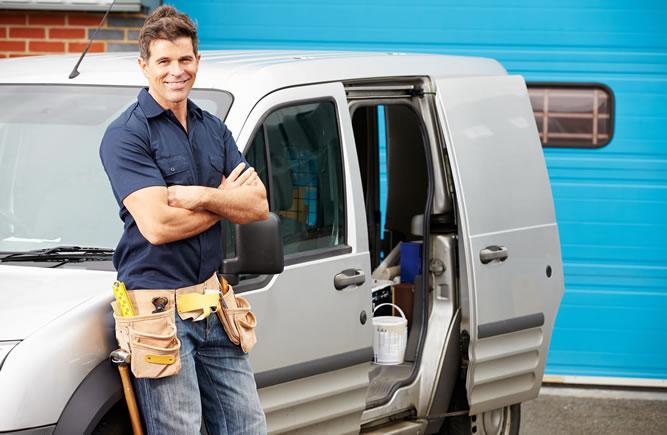Outside Tap Installation Cost
Last updated 18th July, 2025
Would you like to find out how much installing an outside tap costs?
In this guide on outdoor tap fitting, we discuss the price of an outside tap kit, as well as labour and material costs. Average prices will vary anywhere from £80 to £200, depending on your needs.
So, read below for all the details on outside taps!
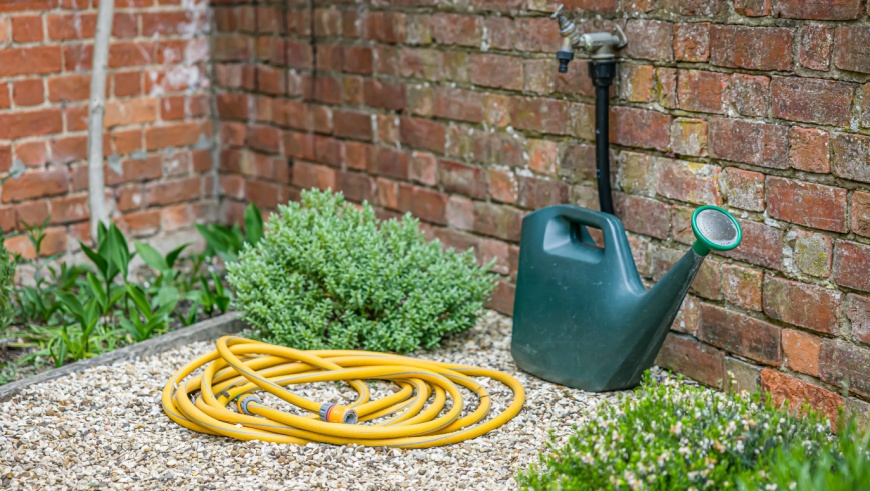
How Much to Fit an Outside Tap?
The cost of installing an outdoor tap has multiple factors including: whether you purchase a tap installation kit or the components separately, whether your plumber provides materials or whether you are installing the tap yourself, and the complexity of the work required.
What other factors need to be considered?
Typically, for a professional to install an outdoor tap costs between £40 and £60 in labour for a straightforward installation, though this can rise to around £200 for more complex work, or if you decide to have two separate taps installed at the same time.
Most plumbers will charge the same rate regardless of whether they are installing a hot or cold tap, as the process is nearly identical.
Outside Tap Fitting Prices
As a general rule, the average, straightforward outdoor tap installation takes roughly 1 hour to complete, with many plumbers offering to supply materials alongside the installation.
| TAP TYPE | AVERAGE COST | DURATION |
|---|---|---|
| Cold tap | £80 - £150 | 1 – 2 hours |
| Hot tap | £120 - £180 | 1 – 2 hours |
| Hot tap with thermostatic mixing valve | £150 - £170 | 1 – 2 hours |
| Separate hot and cold taps | £140 - £200 | 2 – 3 hours |
How Much Are Outside Taps?
In some instances, you may decide to source your own materials prior to your outdoor tap installation.
Supply costs vary according to retailer and quality of materials, but as a rough indication, you can expect the following costs:
| MATERIAL | SUPPLY COST |
|---|---|
| Bib tap | £15 - £30 |
| Standard tap | £5 - £20 |
| Thermostatic mixer valve | £20 - £50 |
| Backplate | £5 - £15 |
You may want to consider purchasing an outdoor tap kit from a trusted retailer, which can be cheaper than buying components individually, usually at the cost of between £20 and £35. However, make sure to do your research before purchasing and check that the kit is up to British Standards.
Outside Tap Cost Breakdown Calculator
The cost to install an external cold water tap: Total Cost: £100
Materials
£40
Labour
£60
Waste Removal
£0
Table of Contents
- How much to fit an outside tap?
- How much are outside taps?
- Labour cost to install outside tap
- What factors impact outside tap installation costs?
- Choosing an outside tap
- What does installing an outside tap involve?
- Building regulations for outside tap installations
- DIY outside tap installation
- Cost of outside tap replacement or removal
- FAQs
- How to find and hire an outside tap installer
- Sources
Labour Cost to Install Outside Tap
The average cost quoted for a straightforward garden tap fit is £100.
Most plumbers will be able to install an outside tap on your external wall adjoining the kitchen within 1 to 2 hours.
A straightforward job will cost around £40 to 60 per hour or the equivalent of £80 to £120 in labour for a larger job, depending on location and accessibility.
What Factors Impact Outside Tap Installation Costs?
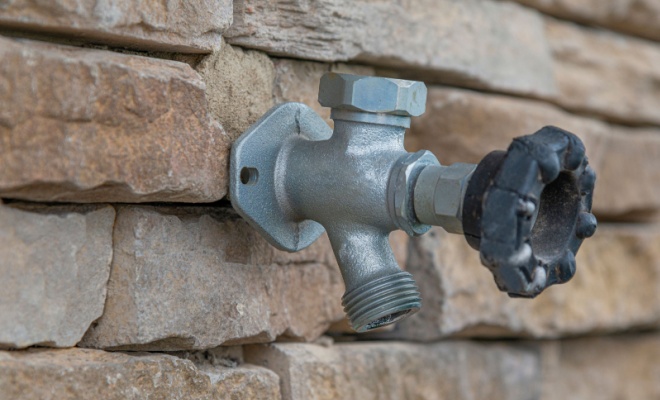
There are a couple of factors that can affect the cost of installing an outdoor tap that you will need to consider, as they may influence your budget.
Adding a Thermostatic Valve
Whether you are having a hot or a cold tap installed, the cost will be the same – however, hot water taps are not temperature-controlled and will require an additional thermostatic valve installed if you don't want to risk scalding. This is a particularly important consideration for homes with children present who may use the tap.
Thermostatic valves cost around £20 each.
Ease of Access
Access to the site can influence the cost of installation. If your plumber arrives and needs to spend time moving objects out of the way to access the tap installation location, you will be charged for their time. You should always prepare the space for a hired tradesperson before their arrival, if you can.
Location
You should keep in mind as well that your location within the UK can have an effect on the cost of your installation. Plumber prices are higher in London and the South East, meaning professional outdoor tap fitting will cost more there than in the North or Midlands.
If you're outside of your tradesmen's usual catchment area, they may also charge extra fees to carry out this installation. The best thing you can do is ask for a fixed quote for this type of work.
Installation Site
The cost of having an outside tap installed increases significantly when the tap cannot be directly connected to existing pipework through the external wall.
If you require a tap to be installed on a wall that is not directly behind your sink (which is the usual location for an external tap) you will inherently need more work to be carried out in order for the installation to take place.
For example, if the sink is on a far wall or kitchen island, this will generally require more extensive work, such as floor removal and replacement to accommodate the new pipe. In turn, this will drive up the overall cost and may require multiple tradespeople.
If you suspect your installation will not be straightforward, ask plumbers for a free quote onsite before agreeing to any work.
Materials
The materials of your home may also affect the cost of installation; drilling through a brick wall is an easier task than drilling through, for example, a granite wall and will take less time to complete.
The use of an outside tap kit can drastically reduce the overall cost of materials compared to the individual purchase of materials, though some plumbers are wary of using such kits and prefer to complete the work themselves.
It's best to discuss the installation method that your plumber would recommend against the proposed cost of work.
Choosing an Outside Tap
There are two types of outdoor taps available on the market:
- A bib tap, which faces directly downwards.
- A standard tap, which points out at a slight angle.
Each of these tap types can be used for either hot or cold water usage, and the choice of which you prefer should be based on how you envisage the tap will be most used.
You should be sure, no matter which type you use, that it is connected to a check valve, under building and water regulations, to avoid the risk of Legionella bacteria contaminating the water supply.
Bib Outside Tap Cost
A bib tap is well suited for use where you are planning to fill containers directly underneath the outlet, and is usually installed directly above garden drains to help with the dispersal of overflow.
You may also wish to consider installing a bib tap if you have a permanent hose connection and wish for the materials to lie close to the wall.
Copper bib taps typically cost between £15 and £30 each.
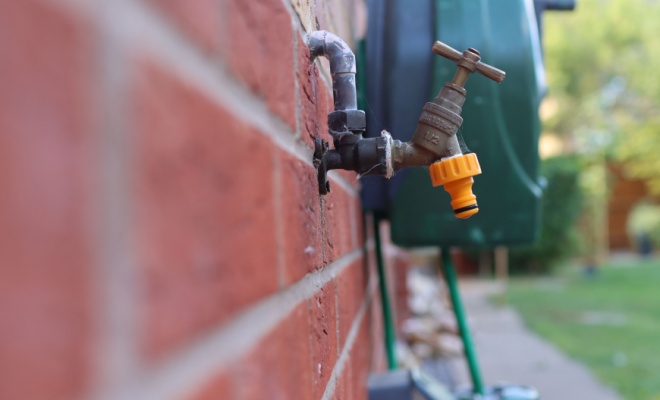
Standard Outside Tap Cost
A standard tap, by comparison, is better suited for infrequent connections (such as a hose) where you have more space around the tap itself to manoeuvre materials and do not require the connecting equipment to be flush with the wall.
Standard copper outdoor taps can range in price from £5 to £20.
What Does Installing an Outside Tap Involve?
Whether you're having a hot or a cold tap installed, the process is the same.
Let's assume a straightforward installation where the tap is being installed on an exterior wall behind your kitchen sink, which is the most common and easiest location to install a tap:
- The location for the new outside tap will be marked on the exterior wall, below the height of your kitchen worktops and usually within 1 metre of the pipe it will be connected to.
- The hole will be drilled to accommodate the copper pipework and adequate insulation.
- After checking the positioning of tap, the screws can be lined up and the holes drilled for those.
- Next, copper piping will be connected to the flange of the tap, ensuring the joint is tight and that PTFE tape has been applied for a snug fit.
- The copper pipe can then be fed into the wall, and the flange secured to the external wall, ensuring the tap is in a downward position.
After this, there are two possible methods to complete the job: a stainless-steel flexible hose can be used as your water transportation method, or solid pipework can be used.
The right choice for your outside tap will depend on factors such as space availability, preference and location of the water source – your plumber will advise you which is best to use in your circumstances.
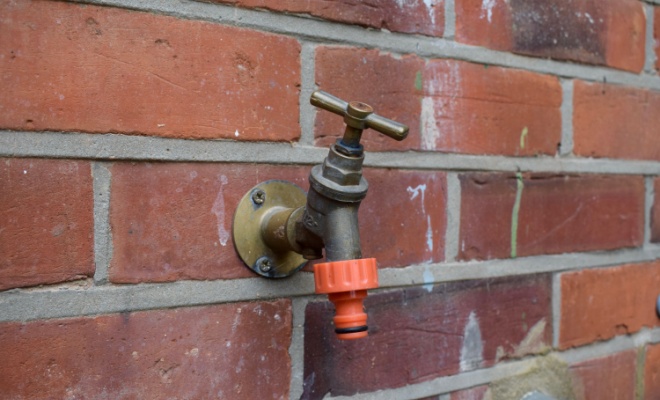
Using a Flexible Hose
The protruding copper pipe will be connected to the hose valve and secured.
Next, a saddle valve will be connected to the desired water pipe; this will create a puncture that will allow water to flow to the external tap.
Once checked and secured, the remaining end of the hose can be connected to the valve.

Using a Solid Pipe
Your existing internal pipework will likely need to be cut and a T joint added to allow water to the external tap.
The T-joint will likely be made of brass and may be soldered into place, or may be part of a clip fitting.
The isolation valve usually sits just above the join, and you may have a drain-off point installed as well to help prevent frozen water from expanding and damaging your pipes in the colder months.
Once all pipework has been secured into place, the water supply can be turned back off, and the tap should be tested to ensure it is correctly fitted and that there are no leaks within the system.
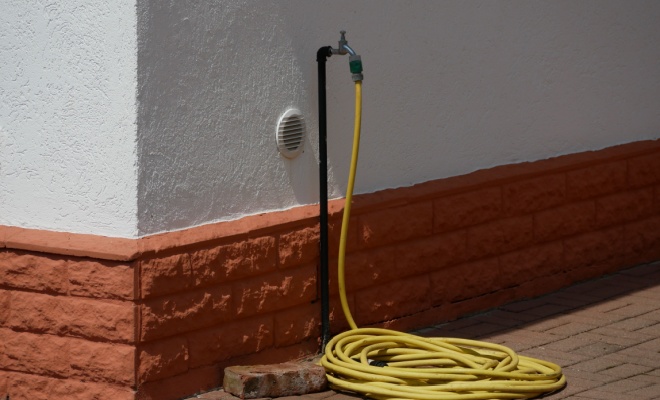
Building Regulations for Outside Tap Installations
When installing an outside tap on your property, there are building regulations that need to be observed:
- You must make suitable provisions for backflow protection to avoid water contamination, such as the installation of a non-return (check) valve.
- External taps must be suitably insulated to prevent freezing.
- The pipework and tap must be earthed to prevent them from becoming electrically unsafe.
If you are using a tradesperson that is registered with a competent person scheme, you will not need to seek approval yourself, and in most cases, planning permission is not required when installing an outdoor tap.
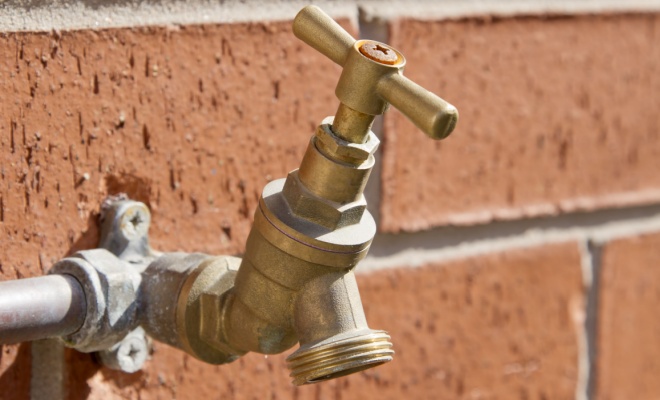
Providing the materials used have a CE mark, they are compatible with UK standards and will not require external verification of their suitability for use.
For further information regarding building regulations and planning permissions for outdoor taps, and whether restrictions apply to your property, you can visit your local building authority website.
DIY Outside Tap Installation
Many DIY enthusiasts are capable of installing an outdoor tap themselves, and there are kits available to make the process as streamlined as possible where straightforward installation is possible.
You'll need to be aware of factors including:
- Having the right equipment for the job, including safety equipment like goggles.
- Ensuring you turn your water supply off at the stopcock to avoid accidental flooding.
- It's your responsibility to check the new tap conforms to building regulations, including having a check valve installed to ensure water can't run back into the system and that it's suitably insulated.
By completing the work yourself, you could save around £50 to £100, depending on labour charges in your area – with DIY kits costing from £20 upwards – making a great saving if you are comfortable undertaking the work yourself.
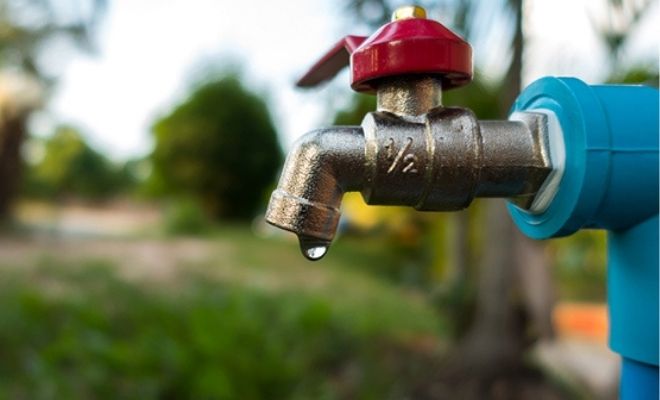
In cases where the tap installation is less straightforward, for example where water pipes are located on the other side of the connecting room, it's recommended that you leave the work to the professionals, particularly where extensive work will need to be carried out unless you are confident in your ability to do so yourself.
Cost of Outside Tap Replacement or Removal
Sometimes it may be necessary to have an outdoor tap removed, for example, if it is faulty or you are planning a home extension covering the area where the tap is connected.
Whatever the reason, it should be a fairly straightforward task for your local plumber or building tradesman to complete.
Before any work can be undertaken, the water will need to be shut off from the location to avoid accidental flooding and potential property damage.
Outside Tap Replacement Cost
If a replacement is being made, then your plumber will simply have to remove and replace the external tap; this is done by gripping the adjustable spanner on the neck of the tap and twisting; there may be a need to use grips to hold the wall mount if the joint is particularly tight.
Once the tap has been removed, the replacement tap will be connected to the existing pipework, once some PTFE has been applied to the thread to ensure a snug fit.
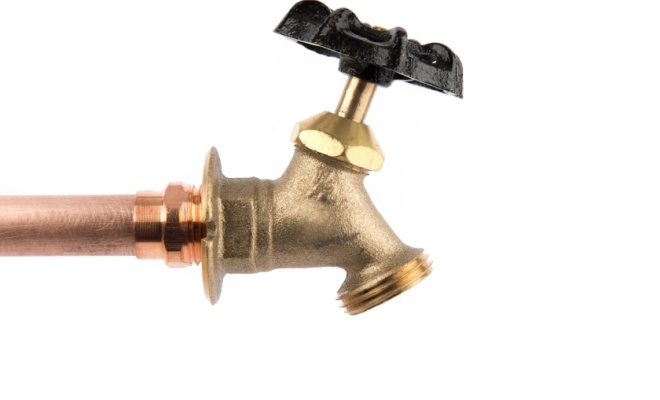
Typically, a replacement tap should cost in the region of £10 to £15 if you decide to undertake the work yourself, or a plumber may complete the work for you for as little as £30 to £50.
Outside Tap Removal Cost
In the event that the external tap needs to be removed completely, the tap will be removed with the same process.
Internally, the pipework leading to the tap will need to be removed to ensure that no water remains in the system that could cause contamination.
The process should take less than an hour to complete, so a charge of around £40 to £60 should be expected for labour.
Your local recycling centre should accept any discarded pipework and tap fittings, or your plumber may offer to remove them from the site for free for you.
FAQs
Try spraying the valve with a lubricant and see if this solves the issue; otherwise, you may need to remove the tap and replace any broken washers.
How to Find and Hire an Outside Tap Installer
Fitting an outdoor tap is a relatively straightforward process that many plumbers should be equipped to handle with minimum stress and setbacks.
Here are some tips to find the right plumber for your job:
- Get multiple quotes and compare a plumber's experience (if details are available).
- Talk to friends or neighbours who have had an outdoor tap fitted to see if they have any recommendations.
- Choose a plumber who is a member of a competent person scheme, as they will be able to self-certify that their work is to the correct standard.
- Check that they have insurance in case something goes wrong.
If you are unsure of which plumbers to contact for outside tap fitting, you can get three free quotes here from tradesmen in your area.
Sources
https://www.gov.uk/building-regulations-approval/use-a-competent-person-scheme
https://www.rightio.co.uk/advice-hub/consider-installing-garden-tap
https://www.waterworld.com/wastewater-treatment/article/16197251/understanding-check-valves-sizing-for-the-application-not-the-line-size
